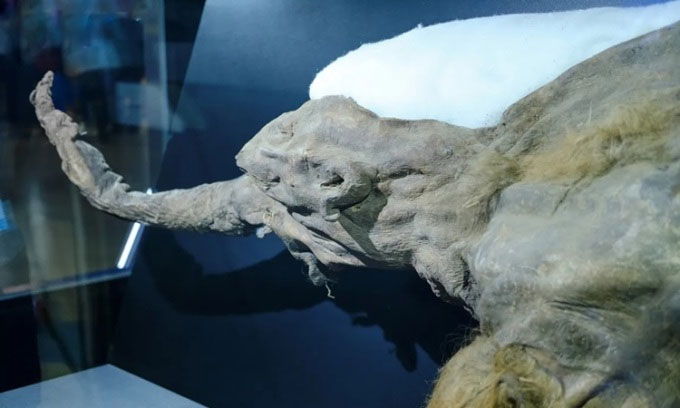39,000-year-old frozen mammoth butchered by ancient humans
The incisions and cuts on the skin of the mammoth mummy were the result of ancient people trying to butcher it with stone tools.
Described as the most intact woolly mammoth carcass ever discovered, the young female specimen named Yuka surprised scientists in a study published in the journal Archaeological Science: Reports. Through analysis of cut marks on the animal's skin, the team determined that it was butchered by humans 39,000 years ago. This is the earliest evidence of human existence in the Arctic, IFL Science reported on September 27.

The Yuka mammoth was probably killed by cave lions and butchered by prehistoric humans. (Photo: Zhuravlev Andrey).
Discovered in 2010 in the far north of Siberia, Yuka was between six and nine years old when she died, possibly hunted by cave lions. Scientists believe her body froze after falling into a lake, thereby maintaining pristine conditions for nearly 40,000 years.
Since its excavation, Yuka's intact mummy has become the target of researchers who want to clone and resurrect the woolly mammoth. Initial studies of the ancient mammoth's remains revealed that it still contained liquid blood, and that some of its cell nuclei continued to show signs of biological activity. Examination also revealed a meter-long gash along Yuka's back, as well as several cuts around its eye sockets. The discovery raises some intriguing questions, including whether the wound was inflicted by a human or an animal.
To find out, the new study's authors conducted several experiments on cow hides and other mammoth hides, and performed a trace analysis of Yuka's skin incisions. They found that the incisions had several distinctly different characteristics from animal wounds, suggesting they were the result of human activity.
The next question, therefore, was whether the incisions occurred at the time of Yuka's death or later. To find out, the team made a series of experimental cuts using both a prehistoric stone blade and a metal knife, and then compared them to the cuts on the mammoth's skin. They concluded that the marks on Yuka's mummy were consistent with experiments cutting mammoth skin with a heated stone plate. For example, the animal's lacerations did not have the sharp, angular edges that metal knives would have.
The researchers concluded that the cuts on Yuka's skin were made by prehistoric people using stone tools. Based on the state of preservation of the skin, it is certain that all the cuts were made close to the time of death. They determined that the ancient people cut Yuka's body to get meat before it froze 39,000 years ago.
- 42,000 year old mammoth exhibition
- Restoring mammoths from corpses
- Display of 39,000-year-old mammoth corpses
- 15,000-year-old mammoth trap discovered in Mexico
- Ancient mammoth resurrection by cloning
- The 700,000-year fossil suspected to be 'precious' mammoth
- Display of mammoth corpses intact
- Mammoth exhibition 39,000 years ago
- Detecting debris from a 40-thousand-year-old mammoth ivory statue
- Fossil three million year old mammoth teeth on the English coast
- Study mammoth brain
- A 12-year-old boy found 10,000 years of fossil mammoth teeth
 Discovered an ancient centipede fossil 99 million years old
Discovered an ancient centipede fossil 99 million years old Discovered bat-like dinosaurs in China
Discovered bat-like dinosaurs in China Discovered a 200-year-old bronze cannon of the coast
Discovered a 200-year-old bronze cannon of the coast Discover 305 million-year-old spider fossils
Discover 305 million-year-old spider fossils Mammoth exhibition 39,000 years ago
Mammoth exhibition 39,000 years ago  Find the remains of the mammoth intact
Find the remains of the mammoth intact  Study mammoth brain
Study mammoth brain  Robot testing the foundation
Robot testing the foundation 